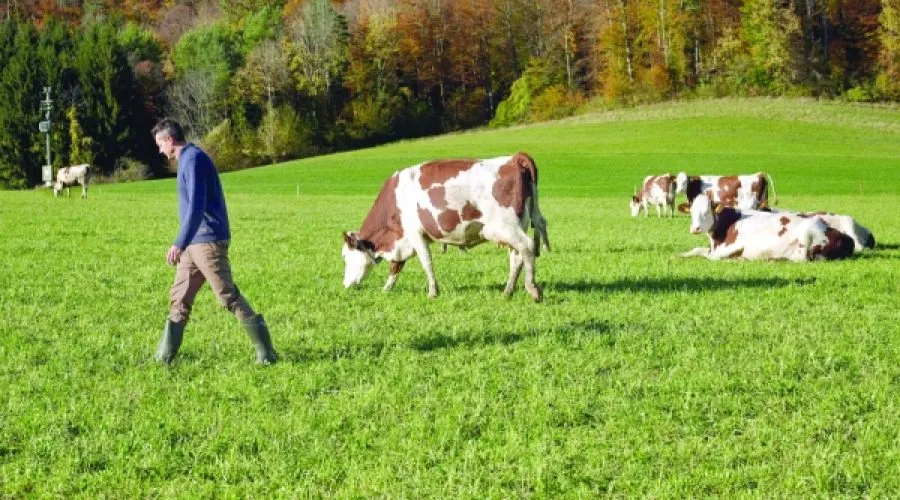Trump’s Tariffs Trigger Swiss Milk Glut: What This Means for Dairy Investors and Exporters
Boris Beuret, a dairy farmer in Switzerland’s Jura region, manages more than 60 cows whose milk, enriched by the region’s tender grasses, is used to produce fine Swiss cheeses and chocolates, much of which is exported to the United States. However, following the imposition of a 39% tariff on Swiss goods by the Trump administration in August, Beuret was compelled to send some of his herd to slaughter prematurely—a move now under consideration by many Swiss dairy farmers.
The tariffs have severely impacted the Swiss dairy industry, prompting cheese makers to reduce production in anticipation of diminished demand from the U.S. This trade challenge exacerbates an existing issue: Switzerland’s dairy sector already produces a surplus of milk and sustains a large cow population.
“We need to find a solution with the United States to lower the tariffs,” Beuret stated. “If conditions persist, we may need to increase the culling of cows.” The dairy cow is a potent symbol of Swiss heritage, recognized for their large copper bells and high-quality milk, making the situation particularly poignant.
As President Trump unveiled new trade agreements during his recent Asia tour, the broader consequences of his tariffs have become apparent. Economic fallout includes factory closures in Africa and job cuts in European auto plants, with Switzerland’s dairy farms now illustrating the trade war’s local impact.
Switzerland’s approximately 20,000 dairy farms produce 90% of the nation’s milk, favoring traditional farming methods over industrial scale. Each summer, around 550,000 cows are led to Alpine pastures, producing high-quality milk that contributes to cheeses like Gruyère, Emmentaler, Tilsiter, and Appenzeller, as well as Swiss chocolate. Milk production and pricing are carefully regulated to sustain these farms.
An unusually rainy spring boosted grass growth, enabling Swiss cows to produce a record milk yield. Ordinarily, excess milk could be processed into milk powder or frozen butter, but the new tariffs have disrupted these arrangements.
The United States, Switzerland’s largest cheese export market after Europe, imports 13% of Swiss cheese production, including premium Gruyère made from Alpine milk. Anthony Margot, co-owner of Margot Fromages, a major Swiss cheese dealer established 139 years ago, expressed shock at the 39% tariff, which far exceeds the 15% expected from the European Union agreement. Combined with other levies and a weakened U.S. dollar, the actual tariff impact exceeds 50%.
Switzerland maintains zero tariffs on most imports but enforces levies surpassing 100% on agricultural products to protect its dairy sector. Margot acknowledged both sides’ protectionist measures but criticized the U.S. tariffs. The increased export costs led Gruyère producers to reduce cheese output by 5%.
Margot’s company ages about 10% of Swiss Gruyère production, exporting 4,500 tonnes to 40 countries, including the U.S. Retail prices have soared, with cheese now selling between $20 and $70 per pound, up from $15 to $50.
To mitigate the resulting oversupply and price declines, the Swiss dairy sector group IP Lait recommended a 50,000-tonne reduction in annual milk production—equivalent to 25,000 cows’ output—primarily through culling animals earlier than usual. Beuret, also president of the Swissmilk producers association, has preemptively culled three cows and is contemplating further reductions, though many farmers hesitate due to hopes for tariff relief. “In Switzerland, the cow is almost a sacred animal,” Beuret remarked. “Discussing culling more cows sends shock waves.”
Efforts to manage the surplus bottle-neck include increasing domestic production of mozzarella and yogurt, encouraging Swiss consumers to consume more dairy through solidarity campaigns, and even moderating cow feeding to reduce milk volume.
In response to the tariffs, Switzerland is accelerating trade negotiations with Latin America, India, and China, with the latter showing growing openness to Swiss dairy imports. “Americans should know that the whole world is starting to organize trade without the United States,” said Stefan Kohler, IP Lait’s director.
— Source: New York Times
Special Analysis by Omanet | Navigate Oman’s Market
The imposition of steep U.S. tariffs on Swiss dairy exports highlights the profound risk trade tensions pose to traditional agricultural sectors, even those steeped in heritage. For Omani businesses and investors, this underscores the importance of diversifying export markets and innovating product lines to mitigate volatility from geopolitical shifts. Smart entrepreneurs should consider exploring alternative international trade partnerships and value-added dairy or agricultural products to sustain growth amid global protectionism trends.



